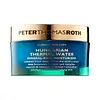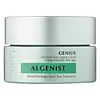What's inside
What's inside
 Key Ingredients
Key Ingredients

 Benefits
Benefits

 Concerns
Concerns

 Ingredients Side-by-side
Ingredients Side-by-side

Water
Skin ConditioningDimethicone
EmollientPEG/PPG-18/18 Dimethicone
EmulsifyingCetyl Alcohol
EmollientGlyceryl Stearate
EmollientPEG-100 Stearate
Cholesterol
EmollientC12-15 Alkyl Benzoate
AntimicrobialLauryl PEG-9 Polydimethylsiloxyethyl Dimethicone
Skin ConditioningCeramide NP
Skin ConditioningRetinyl Palmitate
Skin ConditioningTocopheryl Acetate
AntioxidantAscorbyl Palmitate
AntioxidantGlycerin
HumectantAdenosine
Skin ConditioningHoney
HumectantDiamond Powder
AbrasivePhospholipids
Skin ConditioningTrehalose
HumectantHelianthus Annuus Seed Oil
EmollientLinum Usitatissimum Seed Oil
PerfumingOenothera Biennis Oil
EmollientPrunus Armeniaca Kernel Oil
MaskingPrunus Persica Kernel Oil
EmollientHippophae Rhamnoides Oil
EmollientRosmarinus Officinalis Leaf Extract
AntimicrobialPaeonia Lactiflora Root Extract
Skin ConditioningFagus Sylvatica Bud Extract
TonicSaccharomyces/Magnesium Ferment
Leuconostoc/Radish Root Ferment Filtrate
AntimicrobialSaccharomyces/Iron Ferment
Skin ConditioningSaccharomyces/Copper Ferment
Skin ConditioningSaccharomyces/Silicon Ferment
Skin ConditioningSaccharomyces/Zinc Ferment
Skin ConditioningLecithin
EmollientSodium PCA
HumectantSodium Hydroxide
BufferingPolysilicone-11
Polymethylsilsesquioxane
Mica
Cosmetic ColorantDecyl Glucoside
CleansingEthoxydiglycol
HumectantCarbomer
Emulsion StabilisingDisodium EDTA
Butylene Glycol
HumectantPropylene Glycol
HumectantHexylene Glycol
EmulsifyingCaprylyl Glycol
EmollientBenzoic Acid
MaskingBenzyl Alcohol
PerfumingSodium Benzoate
MaskingPotassium Sorbate
PreservativePhenoxyethanol
PreservativeWater, Dimethicone, PEG/PPG-18/18 Dimethicone, Cetyl Alcohol, Glyceryl Stearate, PEG-100 Stearate, Cholesterol, C12-15 Alkyl Benzoate, Lauryl PEG-9 Polydimethylsiloxyethyl Dimethicone, Ceramide NP, Retinyl Palmitate, Tocopheryl Acetate, Ascorbyl Palmitate, Glycerin, Adenosine, Honey, Diamond Powder, Phospholipids, Trehalose, Helianthus Annuus Seed Oil, Linum Usitatissimum Seed Oil, Oenothera Biennis Oil, Prunus Armeniaca Kernel Oil, Prunus Persica Kernel Oil, Hippophae Rhamnoides Oil, Rosmarinus Officinalis Leaf Extract, Paeonia Lactiflora Root Extract, Fagus Sylvatica Bud Extract, Saccharomyces/Magnesium Ferment, Leuconostoc/Radish Root Ferment Filtrate, Saccharomyces/Iron Ferment, Saccharomyces/Copper Ferment, Saccharomyces/Silicon Ferment, Saccharomyces/Zinc Ferment, Lecithin, Sodium PCA, Sodium Hydroxide, Polysilicone-11, Polymethylsilsesquioxane, Mica, Decyl Glucoside, Ethoxydiglycol, Carbomer, Disodium EDTA, Butylene Glycol, Propylene Glycol, Hexylene Glycol, Caprylyl Glycol, Benzoic Acid, Benzyl Alcohol, Sodium Benzoate, Potassium Sorbate, Phenoxyethanol
Water
Skin ConditioningCaprylic/Capric Triglyceride
MaskingHydrogenated Polyisobutene
EmollientGlycerin
HumectantChlorella Protothecoides Oil
EmollientDimethicone
EmollientButylene Glycol
HumectantGlyceryl Stearate
EmollientPEG-100 Stearate
Butyrospermum Parkii Butter
Skin ConditioningPentylene Glycol
Skin ConditioningPotassium Cetyl Phosphate
EmulsifyingParachlorella Beijerinckii Exopolysaccharides
Skin ProtectingCollagen
MoisturisingCeramide NP
Skin ConditioningCynara Scolymus Leaf Extract
Skin ConditioningRetinyl Palmitate
Skin ConditioningAstragalus Membranaceus Root Extract
EmollientAtractylodes Macrocephala Root Extract
Skin ConditioningIris Florentina Root Extract
MaskingBupleurum Falcatum Root Extract
Skin ConditioningCopper Lysinate/Prolinate
Skin ConditioningMethylglucoside Phosphate
Skin ConditioningStearalkonium Bentonite
Gel FormingAcrylates/C10-30 Alkyl Acrylate Crosspolymer
Emulsion StabilisingSilica
AbrasiveCaprylyl Glycol
EmollientSodium Hydroxide
BufferingDisodium EDTA
Ethylhexylglycerin
Skin ConditioningCetyl Alcohol
EmollientPropylene Carbonate
SolventQuartz
AbrasivePhenoxyethanol
PreservativeLeuconostoc/Radish Root Ferment Filtrate
AntimicrobialChlorphenesin
AntimicrobialParfum
MaskingCoumarin
PerfumingWater, Caprylic/Capric Triglyceride, Hydrogenated Polyisobutene, Glycerin, Chlorella Protothecoides Oil, Dimethicone, Butylene Glycol, Glyceryl Stearate, PEG-100 Stearate, Butyrospermum Parkii Butter, Pentylene Glycol, Potassium Cetyl Phosphate, Parachlorella Beijerinckii Exopolysaccharides, Collagen, Ceramide NP, Cynara Scolymus Leaf Extract, Retinyl Palmitate, Astragalus Membranaceus Root Extract, Atractylodes Macrocephala Root Extract, Iris Florentina Root Extract, Bupleurum Falcatum Root Extract, Copper Lysinate/Prolinate, Methylglucoside Phosphate, Stearalkonium Bentonite, Acrylates/C10-30 Alkyl Acrylate Crosspolymer, Silica, Caprylyl Glycol, Sodium Hydroxide, Disodium EDTA, Ethylhexylglycerin, Cetyl Alcohol, Propylene Carbonate, Quartz, Phenoxyethanol, Leuconostoc/Radish Root Ferment Filtrate, Chlorphenesin, Parfum, Coumarin
 Reviews
Reviews

Ingredients Explained
These ingredients are found in both products.
Ingredients higher up in an ingredient list are typically present in a larger amount.
Butylene Glycol (or BG) is used within cosmetic products for a few different reasons:
Overall, Butylene Glycol is a safe and well-rounded ingredient that works well with other ingredients.
Though this ingredient works well with most skin types, some people with sensitive skin may experience a reaction such as allergic rashes, closed comedones, or itchiness.
Learn more about Butylene GlycolCaprylyl Glycol is a humectant and emollient, meaning it attracts and preserves moisture.
It is a common ingredient in many products, especially those designed to hydrate skin. The primary benefits are retaining moisture, skin softening, and promoting a healthy skin barrier.
Though Caprylyl Glycol is an alcohol derived from fatty acids, it is not the kind that can dry out skin.
This ingredient is also used as a preservative to extend the life of products. It has slight antimicrobial properties.
Learn more about Caprylyl GlycolCeramide NP is a type of ceramide and formally known as ceramide 3.
Ceramides are intercellular lipids naturally found in our skin that bonds dead skin cells together to create a barrier. They are known for their ability to hold water and thus are a great ingredient for dry skin.
Ceramides are an important building block for our skin barrier. A stronger barrier helps the skin look more firm and hydrated. By bolstering the skin ceramides act as a barrier against irritating ingredients. This can help with inflammation as well.
If you would like to eat ceramides, sweet potatoes contain a small amount.
Read more about other common types of ceramides here:
Ceramide AP
Ceramide EOP
Cetyl Alcohol is a fatty alcohol. Fatty Alcohols are most often used as an emollient or to thicken a product.
Its main roles are:
Though it has "alcohol" in the name, it is not related to denatured alcohol or ethyl alcohol.
The FDA allows products labeled "alcohol-free" to have fatty alcohols.
Learn more about Cetyl AlcoholDimethicone is a type of synthetic silicone created from natural materials such as quartz.
What it does:
Dimethicone comes in different viscosities:
Depending on the viscosity, dimethicone has different properties.
Ingredients lists don't always show which type is used, so we recommend reaching out to the brand if you have questions about the viscosity.
This ingredient is unlikely to cause irritation because it does not get absorbed into skin. However, people with silicone allergies should be careful about using this ingredient.
Note: Dimethicone may contribute to pilling. This is because it is not oil or water soluble, so pilling may occur when layered with products. When mixed with heavy oils in a formula, the outcome is also quite greasy.
Learn more about DimethiconeDisodium EDTA plays a role in making products more stable by aiding other preservatives.
It is a chelating agent, meaning it neutralizes metal ions that may be found in a product.
Disodium EDTA is a salt of edetic acid and is found to be safe in cosmetic ingredients.
Learn more about Disodium EDTAGlycerin is already naturally found in your skin. It helps moisturize and protect your skin.
A study from 2016 found glycerin to be more effective as a humectant than AHAs and hyaluronic acid.
As a humectant, it helps the skin stay hydrated by pulling moisture to your skin. The low molecular weight of glycerin allows it to pull moisture into the deeper layers of your skin.
Hydrated skin improves your skin barrier; Your skin barrier helps protect against irritants and bacteria.
Glycerin has also been found to have antimicrobial and antiviral properties. Due to these properties, glycerin is often used in wound and burn treatments.
In cosmetics, glycerin is usually derived from plants such as soybean or palm. However, it can also be sourced from animals, such as tallow or animal fat.
This ingredient is organic, colorless, odorless, and non-toxic.
Glycerin is the name for this ingredient in American English. British English uses Glycerol/Glycerine.
Learn more about GlycerinGlyceryl Stearate is a mix of glycerin and stearic acid.
It is used to stabilize the mixing of water and oil ingredients. By preventing these ingredients from separating, it can help elongate shelf life. It can also help thicken the product's texture.
As an emollient, it helps soften skin and supports barrier-replenishing ingredients.
In cosmetics, Glyceryl Stearate is often made from vegetable oils or synthetically produced.
This ingredient may not be fungal-acne safe
Fun fact: The human body also creates Glyceryl Stearate naturally.
Learn more about Glyceryl StearateLeuconostoc/Radish Root Ferment Filtrate is a natural preservative. It comes from fermenting radish roots with a bacteria called leuconostoc.
Leuconostoc comes from lactic acid.
This ingredient has antimicrobial properties and helps prevent the growth of bacteria in a product.
Leuconostoc is used to make the traditional Korean side-dish, kimchi. It is also used to make sourdough bread (both incredibly yummy foods).
Learn more about Leuconostoc/Radish Root Ferment FiltratePeg-100 Stearate is an emollient and emulsifier. As an emollient, it helps keep skin soft by trapping moisture in. On the other hand, emulsifiers help prevent oil and water from separating in a product.
PEGS are a hydrophilic polyether compound . There are 100 ethylene oxide monomers in Peg-100 Stearate. Peg-100 Stearate is polyethylene glycol ester of stearic acid.
Phenoxyethanol is a preservative that has germicide, antimicrobial, and aromatic properties. Studies show that phenoxyethanol can prevent microbial growth. By itself, it has a scent that is similar to that of a rose.
It's often used in formulations along with Caprylyl Glycol to preserve the shelf life of products.
Retinyl palmitate is a form of retinoid. Retinoids are the superstar class of anti-aging ingredients that include tretinoin and retinol.
This particular ingredient has had a bumpy year with its rise and fall in popularity.
First, Retinyl palmitate is created from palmitic acid and retinol. It is a retinol ester and considered one of the weaker forms of retinoid.
This is because all retinoids have to be converted to Tretinoin, AKA retinoic acid. Retinyl Palmitate is pretty far down the line and has to go through multiple conversions before its effects are seen.
Due to this long and ineffective conversion line, the benefits of Retinyl Palmitate are debated.
Studies show Retinyl Palmitate to help:
Dermatologists say this ingredient is ineffective because it isn't used in high enough concentrations in cosmetics.
This ingredient used to be found in sunscreens to boost the efficacy of sunscreen filters.
The downfall of Retinyl Palmitate was due to released reports about the ingredient being correlated to sun damage and skin tumors.
While there is a study showing this ingredient to cause DNA damage when exposed to UV-A, there is no concrete proof of it being linked to skin cancer. It is safe to use when used correctly.
All retinoids increase your skin's sensitivity to the sun in the first few months of usage. Be especially careful with reapplying sunscreen when using any form of retinoid.
Currently, this ingredient is still allowed in cosmetics all over the world. In Canada, cosmetics must have a warning label stating the product to contain Retinyl Palmitate
Fun fact: This ingredient is often added to low-fat milk to increase the levels of Vitamin A.
Learn more about Retinyl PalmitateSodium Hydroxide is also known as lye or caustic soda. It is used to adjust the pH of products; many ingredients require a specific pH to be effective.
In small amounts, sodium hydroxide is considered safe to use. However, large amounts may cause chemical burns due to its high alkaline.
Your skin has a natural pH and acid mantle. This acid mantle helps prevent harmful bacteria from breaking through. The acid mantle also helps keep your skin hydrated.
"Alkaline" refers to a high pH level. A low pH level would be considered acidic.
Learn more about Sodium HydroxideWater. It's the most common cosmetic ingredient of all. You'll usually see it at the top of ingredient lists, meaning that it makes up the largest part of the product.
So why is it so popular? Water most often acts as a solvent - this means that it helps dissolve other ingredients into the formulation.
You'll also recognize water as that liquid we all need to stay alive. If you see this, drink a glass of water. Stay hydrated!
Learn more about Water